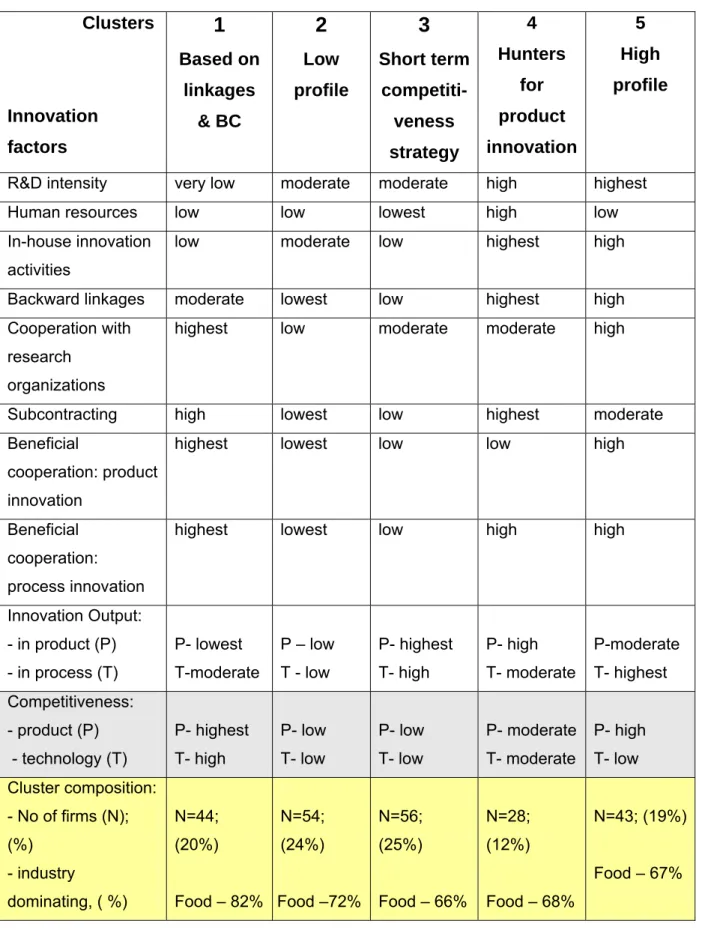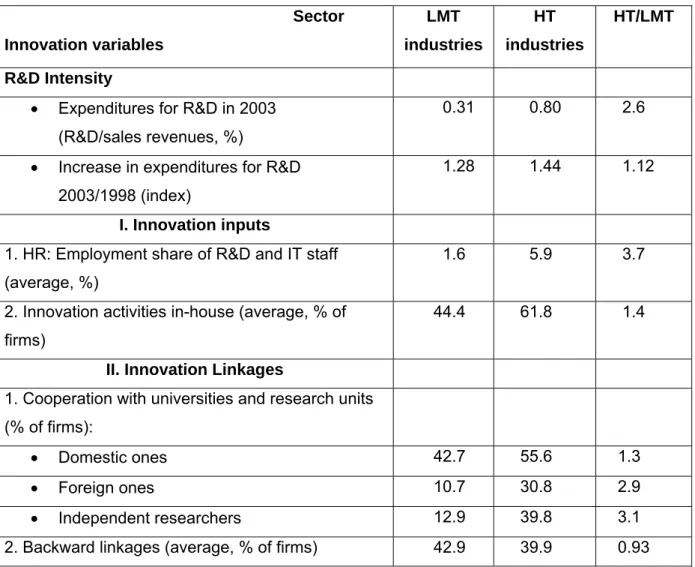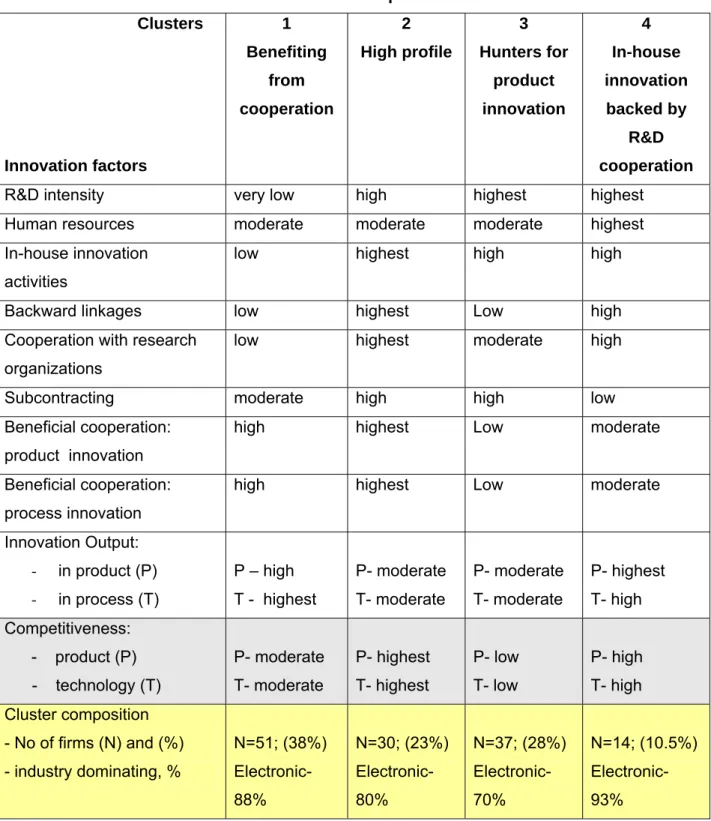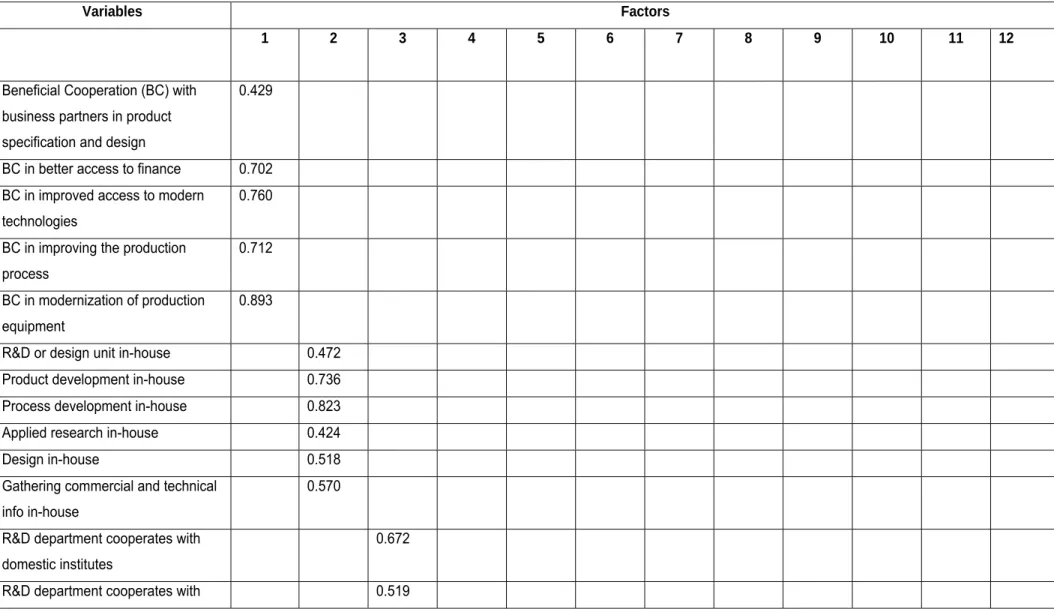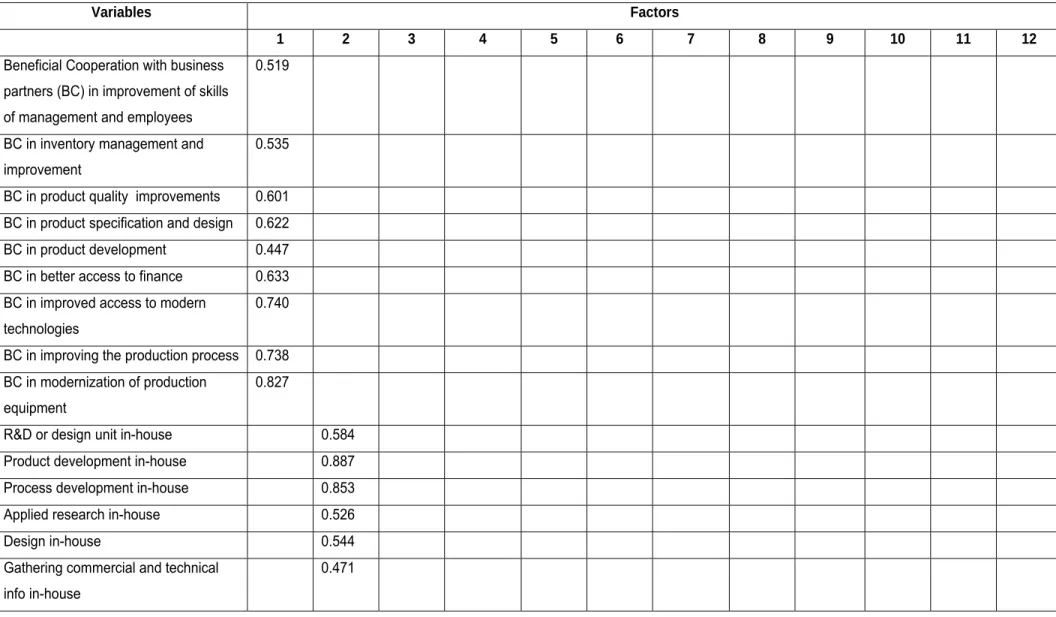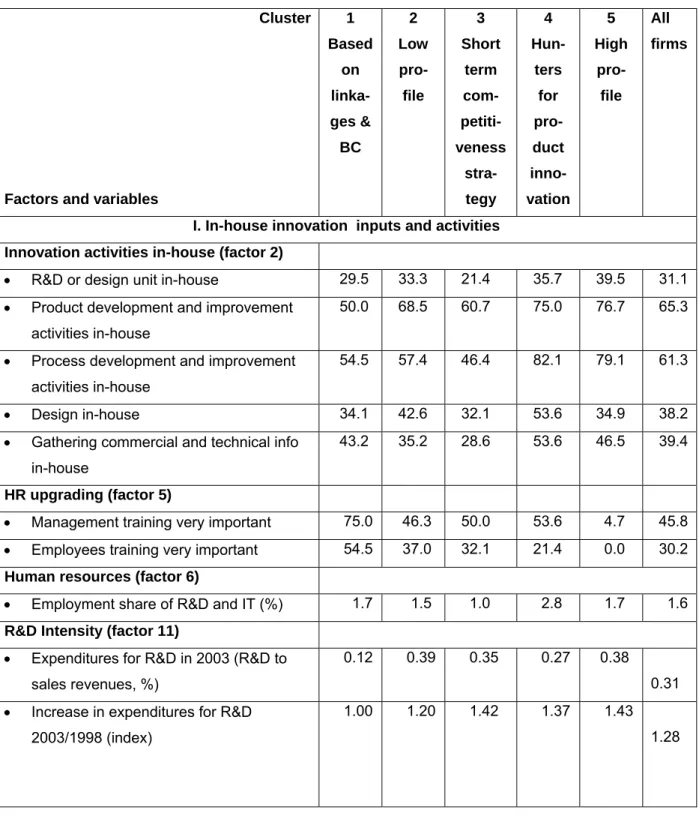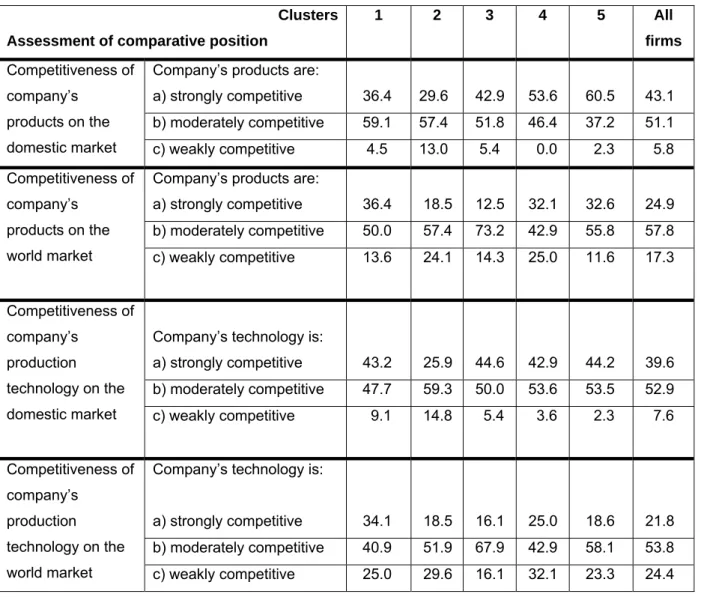One of the main issues for economic growth and competitiveness in the new Member States is their ability to innovate. Next, we summarize the findings of research on differences in innovativeness between LMT and HT sector firms in developed market economies. As far as we know, no analysis of differences in the innovation activities of the companies in these two sectors for NMS has been carried out so far.
The methodology used to detect patterns of innovation in the new Member States is then presented. The last part of Chapter 2 presents and discusses innovation patterns in LMT and HT sector companies in the new Member States.
Background
Typology of industries based on R&D intensity and its relevance to
This literature review is helpful in confronting the findings of our research on the differences in innovation sources, impacts and innovation patterns in the new Member States. The second part of the article begins with a brief presentation of the data source used in the study and an example of a company. In the next section we discuss the differences in innovation activities between the LMT and HT sectors in the three new Member States, and their sources.
We focus on the similarities and differences between innovation patterns in firms in the two sectors and their relationship with economic performance. The obsession with high technology has led to a neglect of the role that innovation plays in the growth and competitive performance of low- and medium-technology industries.
What we know about the differences in innovativeness of the LMT and
Fifth, the perception of the high-tech sector as a crucial driver of economic growth and competitiveness ignores an important fact highlighted by Carrol et al (2003, p. 429). The emphasis that companies in the LMT sector place on the quality of the production process allows them to differentiate themselves from the competition in terms of product quality and reasonable costs. It is worth noting that only part of the LMT sector's production takes place in low-wage countries, while innovation activities remain in OECD countries and strengthen LMT companies.
Many of them are prominent in the less advanced science and technology (the example of patents in the less advanced biology of the food industry, see von Tunzelmann and Acha, 2005; also the example of the tire industry, see Brusoni and Sgalari, 2006). Because their competitiveness reflects their ability to use embodied and disembodied knowledge, “technological competition leads quite directly to the diffusion of technologies between industries and therefore to the inter-industry use of the knowledge 'embodied' in these technologies” (Smith , 2002). , p. 20.).
Innovation patterns of firms in the NMS
Data source and enterprise sample
Food and beverage firms were the most common (45% of the sample), while pharmaceutical firms were the least common (only 7%). Enterprises were grouped into two sectors: the food and beverage producers and the car companies were placed in the low and medium technology (LMT) sector, while the electronics and pharmaceutical firms were placed in the high technology (HT) sector. LMT sector firms constituted 63% of the sample, while the remaining 37% belonged to the HT sector.
Polish firms dominated the sample: they accounted for almost half of the enterprise population surveyed.
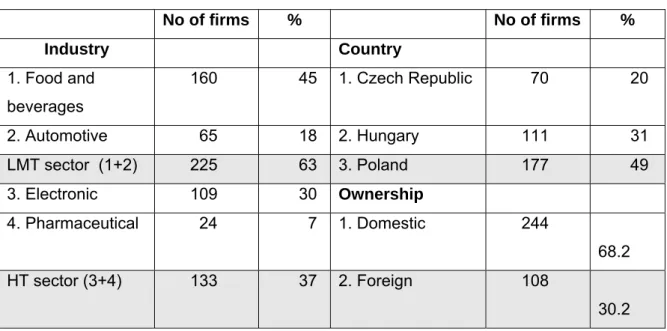
Differences in innovation activities between LMT and HT sectors
It is also worth noting that the distance between the two groups of companies in the accession countries increased over time. However, the observed gap between the two sectors in the new Member States was smaller than expected. 61% of companies in the HT sector continuously carry out internal innovation activities, while in the case of the LMT sector this is only 31% (see data in Tables 8 and 9 in the Annex).
The big difference between the two sectors was revealed in the case of cooperation with foreign research units and with independent researchers, which was used by 3 times more firms in the HT industries than in the LMT sector. As in the case of the existing EU countries, our sample firms' R&D collaboration with suppliers of machinery and equipment as well as raw materials was explored more often in LMT sector firms than in their HT counterparts. This last observation supports the hypothesis regarding the greater focus of LMT sector firms on process innovation, which was confirmed in the case of existing EU economies (see section 1.2 above).
The other two innovation performance measures also indicate the prevalence of companies in the HT sector. In terms of introducing new products to the domestic market, the difference between companies belonging to the two sectors was quite small (only 15%; see Table 2 above). Finally, we will draw conclusions about the financial performance of companies classified in the two sectors.
More firms in the HT sector consider themselves to be strongly competitive in both product and technology and in both local and international markets than firms from the LMT sector (see Table 2 and Tables 9 and 10 in the Appendix). Another interesting, although seemingly obvious, observation is that in the case of both markets (domestic and international), more companies in each of the two sectors consider themselves to be more competitive in terms of their product than in terms of their technology regard. The nominal values show that the vast majority of firms in both sectors do not rate their products as strongly competitive internationally (75% in the case of the LMT sector and 61% . in the case of HT).
Methodology employed to explore innovation patterns
Compared to products, new technology was introduced more often in each of the two sectors: in 2003 the average share of production of manufacturing technology that was less than 2 years old was 53.5% for a HT sector company and 44% for an LMT sector company; the difference was 22%. Furthermore, it is important to note that in both sectors, in the same two-year period, more than half of the firms did not introduce new products for the local market, and a majority (85% in the LMT sector, and 68% in the HT sector). sector) did not introduce new products for the international market. More companies in each of the two sectors also believe that they are strongly competitive on the domestic rather than international market.
This view is similar and somewhat worse in the case of the international competitiveness of the technology used by companies: however, more companies consider their competitiveness to be either moderate or weak compared to international competitors (78% and 62%). PCA helps prevent the inclusion of irrelevant variables and reduces the risk of any single indicator dominating the cluster analysis result. In the next step, a non-hierarchical cluster analysis was performed in order to group companies into several clusters according to innovation variables that were as homogeneous as possible (small variance within the cluster) and at the same time as different as possible from each other (large variance between clusters).
In the appendix, there are two tables that show the results of the factor analysis for LMT sector firms (Table 6) and HT sector firms (Table 7). They include variable loadings on selected factors after so-called rotation. The loadings of the various indicators on the retained factors are correlation coefficients between the indicators (rows of the two tables) and the factors (columns) and provide the basis for the interpretation of the various factors.
12 factors were selected, which together explain 55.4% of the total variance for companies in the LMT sector, and 59.6% for companies in the HT sector. In the second step, we performed a non-hierarchical cluster analysis based on the twelve composite variables extracted in the factor analysis of the first step. The cluster centroids obtained in the hierarchical method were used as initial centroids for the K-means algorithm.
Innovation patterns in LMT and HT sectors in the NMS
The greater innovation resources and involvement in innovation activities of the HT sector firms result in their higher financial performance compared to firms in the LMT sector. This suggests that the diffusion of external knowledge was not widespread, especially in the HT sector companies. It results in a lower share of firms with strong international competitiveness for product and production technology in the HT compared to the LMT sector and confirms that diffusion of external knowledge plays a role in international competitiveness.
Although backward collaboration in R&D was used more often in the LMT cluster than in the HT cluster, the spread of external knowledge was similar. The similarity in the spread of external knowledge and in innovation activities in both clusters results in the similarity in their international competitiveness. Furthermore, it suggests that external knowledge and the ability to use it play a decisive role in the companies' innovation activities in NMS.
In the former, companies using internal research and collaboration with research organizations try to use collaboration to renew their product range as often as possible. The companies' internal innovation resources (namely R&D intensity and share of R&D and IT employees in total employment) were much higher in companies in the HT sector. This finding explains another, namely that in the HT sector more companies developed internal innovation activities and collaborated with external research organizations.
Only R&D collaboration with suppliers was more frequently investigated in LMT sector companies. These two findings indicate that the much lower R&D intensity of firms in the LMT sector was not a significant barrier to the inflow of innovation. It also confirms the key role played by the dissemination of external innovation resources and knowledge for the innovation of LMT sector companies in the new Member States.
There were no major differences in firms' innovation patterns between the two technological sectors, but innovation resources and activities in most groups detected in the LMT sector were lower than in their HT counterparts. Unlike in the LMT sector, no Low Profile innovation pattern was detected in the HT sector. LMT sector firms in the NMS: Group description by types of innovation factors. of cluster firms answering 'yes', except for factors 6, 8 and 11 where other measures apply).
LMT sector in the NMS: Product and technology competitiveness of firms by cluster (% of cluster companies answer 'yes').
